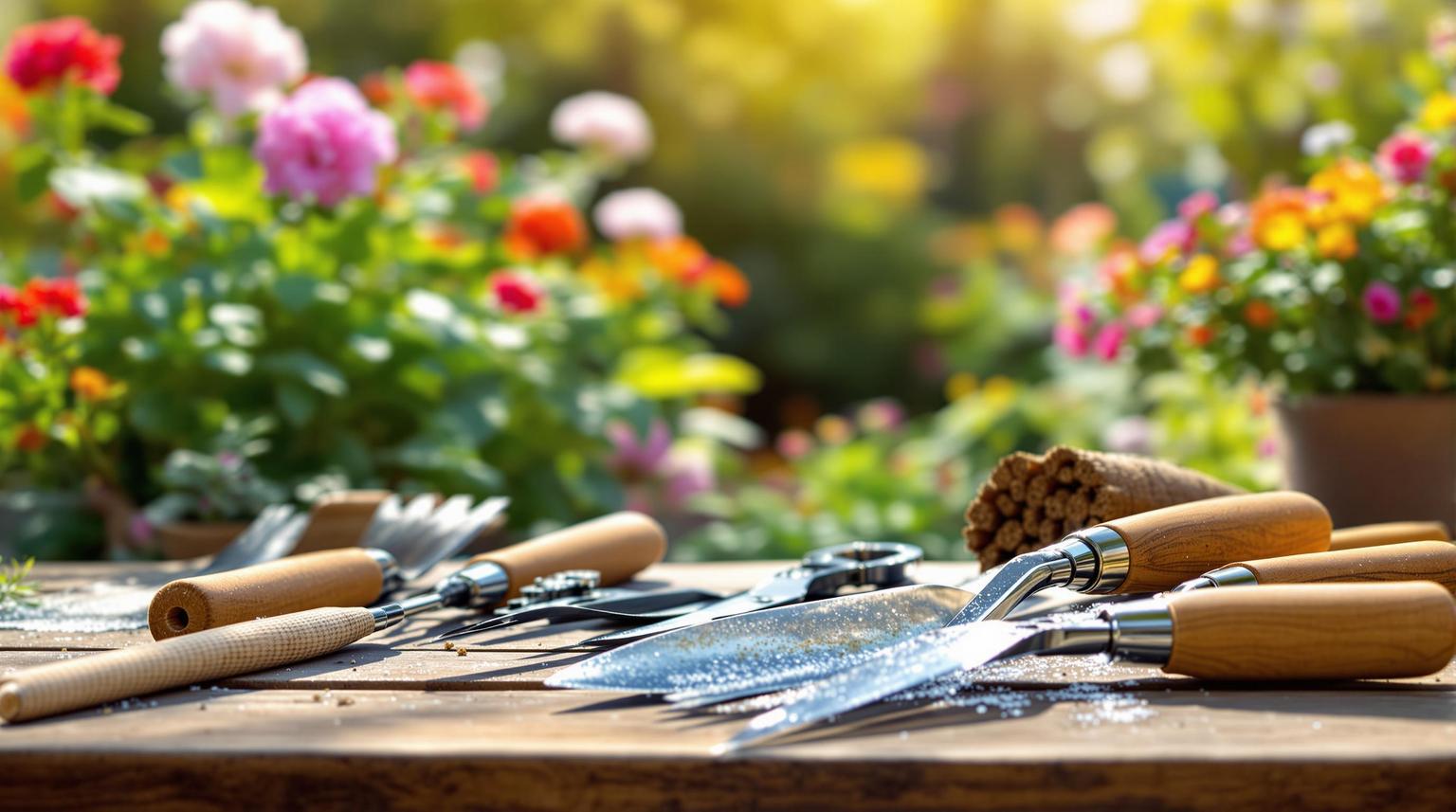
Garden Tool Maintenance: Spring Preparation Guide
Spring is here, and it’s time to prepare your garden tools for the busy season ahead. Clean, sharp, and well-maintained tools not only make gardening easier but also help your plants thrive. Here’s a quick breakdown of what you need to do:
Key Steps for Spring Tool Maintenance:
- Clean & Inspect: Remove dirt and rust, and check for damage.
- Sharpen Cutting Tools: Dull blades harm plants and make work harder.
- Oil Moving Parts: Lubricate joints and metal surfaces to prevent rust.
- Store Properly: Use dry, organized storage to keep tools in top shape.
Why It Matters:
| Benefit | Proper Maintenance | Neglect Consequences |
|---|---|---|
| Performance | Smooth, precise operation | Tools become less effective |
| Plant Health | Encourages healthy growth | Plants are more prone to disease |
| Cost | Tools last longer | Frequent replacements needed |
| Efficiency | Saves time and effort | Tasks take longer and are harder |
Taking just a little time now to care for your tools will save you frustration later. Let’s dive into the details and get your tools ready for a productive gardening season.
How to Clean & Sharpen Your Garden Tools
Step 1: Clean and Check Your Tools
Spring isn’t just for decluttering indoors - it’s also a great time to get your garden tools ready for action. After months in storage, your tools will need a good cleaning and inspection before they’re back in use.
Clean Off Rust and Dirt
Start by tackling any dirt and rust that’s built up on your tools. Here’s what you’ll need:
| Cleaning Supply | Purpose | Where to Find |
|---|---|---|
| Wire brush | Scrape off loose rust and dirt | Poppys.shop Hardware Section |
| Steel wool | Detail cleaning and polishing | Poppys.shop Cleaning Supplies |
| Brasso | Polish and shine metal surfaces | Poppys.shop DIY Department |
| White vinegar | Loosen rust naturally | Local grocery store |
For tough rust spots, soak the area in white vinegar for 24 hours, then scrub with a wire brush or steel wool. This method is gentle on the metal while effectively removing rust. Once cleaned, make sure your tools are completely dry to avoid future rust issues.
A thorough cleaning not only improves performance but also makes it easier to spot damage.
Check for Tool Damage
After cleaning, inspect your tools closely. Pay attention to these areas:
- Handles: Look for cracks, splits, or signs of rot.
- Moving parts: Check for looseness or wobbling.
- Metal surfaces: Look for deep rust, pitting, or structural damage.
- Safety features: Test locking mechanisms and guards to ensure they’re working properly.
Fix or Replace Broken Tools
Decide whether to repair or replace based on the type of damage. Use this guide:
| Damage Type | Repair Option | When to Replace |
|---|---|---|
| Loose handles | Tighten screws or replace the handle | Replace if wood is badly split or rotted |
| Surface rust | Clean and apply a rust inhibitor | Replace if rust has caused deep pitting or weakness |
| Bent tools | Straighten if possible | Replace if metal shows stress cracks |
| Dull blades | Sharpen as needed | Replace if blades are chipped or heavily worn |
If repairs are needed, Poppys.shop has a wide range of parts and supplies in their hardware section. For replacements, consider investing in durable, high-quality tools - they’ll save you time and effort in the long run with proper care.
Step 2: Sharpen Your Cutting Tools
Using sharp tools makes your work easier and results in cleaner cuts that heal faster. If you're struggling with excessive force or notice uneven cuts, it’s likely time to sharpen your tools. Here’s how you can restore their edge effectively.
Tools and Methods for Sharpening
Before starting, grab these supplies from your hardware store:
| Tool Type | Best For |
|---|---|
| Mill file (8–12 in) | Hoes, shovels, spades |
| Whetstone | Pruners, shears, knives |
| Diamond file | Precision blades |
| Steel wool | Removing rust |
| Camellia oil | Protecting blades |
Secure your tool in a vise or clamp, then follow these sharpening methods based on the tool type:
-
Pruners and Shears
Clean them with soapy water and a scouring pad. Soak the whetstone for 10 minutes, then sharpen while maintaining the original bevel. -
Shovels and Hoes
Use a bastard or second-cut mill file. Moisten the file with water to prevent clogging, and file in one direction, following the blade's natural angle. -
Precision Tools
Use a diamond file with light pressure, working from the base to the tip. Check the sharpness as you go.
"A sharp pair of hand pruners makes cleaner cuts that heal more efficiently, resulting in a healthier plant that's better able to fight disease, insect infestation, and natural stresses with strength and vigor." - Melissa Levangie
Stay Safe While Sharpening
Safety is key when working with sharp tools. Keep these precautions in mind:
- Eye Protection: Wear safety glasses to guard against metal filings.
- Work Gloves: Use cut-resistant gloves when handling sharp edges.
- Secure Workspace: Choose a stable, well-lit area to work.
- First Aid Kit: Keep one nearby, just in case.
After sharpening, apply a dry or silicone-based lubricant to the blade. To test the sharpness, slice a piece of paper - it should cut smoothly without tearing.
sbb-itb-05a772f
Step 3: Oil Moving Parts
Keeping your garden tools well-lubricated is key to ensuring they work smoothly and last longer. Oiling reduces friction, protects metal from rust, and helps your tools perform at their best.
Choose the Right Lubricant
Not all lubricants are the same. Pick one that matches your tools and how you use them:
| Lubricant Type | Best For | Features |
|---|---|---|
| WD-40 | Quick maintenance | Loosens rust, repels moisture |
| Machine oil | Heavy-duty tools | Provides durable, long-term protection |
| Silicone spray | Precision tools | Clean application, leaves no residue |
| Mineral oil | Wood handles | Helps preserve and protect wood |
For general upkeep, WD-40 works well. For tougher jobs, like pruning shears or loppers, machine oil offers better durability.
Where to Apply Lubricant
Focus on these areas to keep your tools in top shape:
- Pivot points: Oil the central bolt or rivet on pruners, shears, and loppers.
- Moving joints: Lubricate blade connections and folding mechanisms.
- Metal surfaces: Coat exposed metal to guard against rust.
- Spring mechanisms: Ensure springs move easily and don’t squeak.
- Locking mechanisms: Oil latches and catches for smooth operation.
Once applied, move the parts back and forth a few times to spread the oil evenly. Wipe off any extra oil to avoid attracting dirt.
When to Oil Your Tools
Stick to a regular schedule to keep your tools in great condition:
1. Weekly Maintenance
During peak gardening months (March through October), wipe your tools clean and apply a light coat of oil weekly.
2. Monthly Deep Care
Every month, give your tools a thorough lubrication, covering all moving parts and metal surfaces. Check for any rust and address it promptly.
3. Seasonal Protection
Before storing tools for the winter, apply a heavier coat of oil. When spring comes, clean and reapply lubricant to get them ready for use.
Step 4: Store Tools Correctly
Once you've cleaned, sharpened, and oiled your tools, storing them properly is crucial to keeping them in top shape. A good storage setup not only protects your tools but also makes them easy to find when you need them.
Set Up Tool Storage
Keeping your tools organized and safe from damage starts with smart storage solutions. Here are some options:
| Storage Solution | Best For | Benefits |
|---|---|---|
| Wall-mounted racks | Long-handled tools | Saves floor space by storing tools vertically |
| Pegboards | Hand tools | Offers easy access with a customizable layout |
| Tool cabinets | Power tools, precision equipment | Shields tools from dust and moisture |
| Deck boxes | Seasonal tools | Portable and weather-resistant storage |
For added flexibility, install hooks and clamps at different heights to accommodate various tool sizes. For example, GearHooks Ltd offers wall-mounted systems with galvanized, powder-coated finishes that resist weathering.
Keep Tools in Good Condition
To maintain your tools and storage area, follow these tips:
- Choose a cool, dry space to avoid temperature-related damage.
- Ensure proper ventilation to reduce moisture buildup.
- Use silica gel packs or a dehumidifier in areas with high humidity.
"Storing tools indoors in a shed, garage, or other protected area is generally the best option for maintaining their longevity and functionality." - GearHooks Ltd
Stop Rust Before It Starts
Rust prevention is key, especially during humid seasons like spring. Here's how to keep your tools rust-free:
- Pre-storage care: Clean tools with soapy water or vinegar, dry them thoroughly (a hairdryer works well for tight spots), and coat any metal parts with linseed oil.
- Storage environment: Keep tools off the ground by using shelves or wall mounts to avoid damp surfaces. Posh Living Magazine (July 2024) suggests storing tools in a dry, ventilated area and applying linseed oil to protect against rust.
- Regular checks: Inspect your tools frequently. If you spot rust, clean it off, apply a rust inhibitor, and lightly oil the area.
For outdoor tool storage, use weatherproof containers and check them regularly for moisture. A multi-shelf rack in your garage or shed can also help: store heavier items on the lower shelves and lighter hand tools on top for easy access.
Conclusion: Spring Tool Maintenance Checklist
Once your tools are cleaned, sharpened, and oiled, use this handy checklist to ensure they stay in great shape throughout spring.
| Maintenance Task | Key Actions | How Often |
|---|---|---|
| Clean & Inspect | Remove rust and dirt; check for any damage | After every use |
| Sharpen | Keep cutting edges sharp and align blades | Once a month |
| Lubricate | Oil moving parts and protect metal surfaces | Every 2–3 weeks |
| Store Properly | Keep in a dry area; use wall mounts or racks | Right after use |
This simple guide helps you keep your tools dependable and ready for action all season long.
Need supplies? Stop by Poppys.shop at 43 Church Road, Ton Pentre, CF41 7EG. They offer lubricants, sharpening tools, storage solutions, and replacement parts. Their team is happy to assist! Click-and-collect is available Monday–Friday (10:00 AM–4:00 PM) and Saturday (10:00 AM–2:00 PM).
